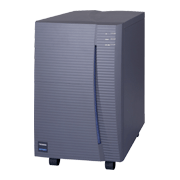Toshiba announced the UX2000i UNIX server in June 1998 as part of its UX series. Although the UX2000i was developed in large part with technology licensed from Sun Microsystems, Toshiba developed its own system service processor for remote server management.
The UX2000i was powered by an UltraSPARC IIi (300 MHz) processor, and internal memory was expandable to 1 GB and internal magnetic disk capacity to 36.4 GB. Toshiba’s ArrayFort disk array, which enabled hot swapping, could be connected to the server. RAID 0, RAID 1, RAID 0+1, and RAID 3 configurations were supported.
The system service processor, which was independent of the CPU, was the main feature that distinguished the UX2000i. The extra processor made it possible to operate, manage, and service the server from a remote location via a network.
Features implemented with the system service processor:
- (1) Remote console functions
- A system console could be used to start the system and change parameter settings, etc. from a remote location.
- (2) Remote server control functions
- Operators from a remote location could power on the system, shut down the system, and forcibly disconnect power to the system.
- (3) Remote acquisition of system status information
- Operators from a remote location could obtain and view information concerning the system’s hardware configuration and the system’s operational status.
- (4) Remote crash memory dump
- Operators from a remote location could run memory dumps.
- (5) RAS functions (fault warning function)
- The server could be configured to transmit notifications about system faults via the Ethernet or a digital I/O board to external systems. This function worked in conjunction with the server’s RAS functions (temperature monitoring, fan monitoring, power-supply fault monitoring, etc.).
| CPU | UltraSPARC II i (300MHz) | ||
|---|---|---|---|
| Memory | 128MB-1GB | ||
| Max. magnetic disk capacity (internal) | 36.4GB Ultra Wide SCSI (40MB/S) |
||
| Ethernet | 10BASE-T/100BASE-T | ||
| Dimensions (h x w x d) | 450x290x540mm | ||
| System service processor | RAS functions | CPU monitoring, temperature monitoring, fan monitoring, power-supply monitoring | |
| Remote functions | Console functions | System start-up and configuration | |
| Server control functions | Power on, shutdown, forcible power disconnection | ||
| System status acquisition | Obtain and view system configuration information and system status information (CPU load, memory usage, etc.) | ||
| Crash dump functions | Forcible restart when the OS locks up, and disk storage of the current memory state | ||
| Fault notification functions | External alerts of system faults (via networks or digital I/O boards) | ||


